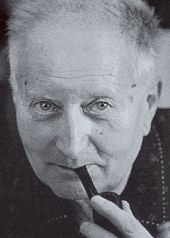Jean Giono
Jean Giono | |
|---|---|
 | |
| Born | 30 March 1895 Manosque, France |
| Died | 8 October 1970 (aged 75) Manosque, France |
| Occupation | Writer |
| Nationality | French |
| Literary movement | Popular culture |
| Notable works |
|
| Website | |
| www | |
Jean Giono (30 March 1895 – 8 October 1970) was a French writer who wrote works of fiction mostly set in the Provence region of France.
First period
Jean Giono was born to a family of modest means, his father a cobbler of
Colline was followed by two more novels heavily influenced by Virgil and Homer,
Throughout the nineteen-thirties, Giono expressed the pacifism he had adopted as a result of his experiences during World War I in novels such as Le grand troupeau (1931), and pamphlets such as Refus d’obéissance (1937), and the Lettre aux paysans sur la pauvreté et la paix (1938).
In 1937, he famously asked, "What is the worst that can happen if Germany invades France?"[6]
Transition
The end of the nineteen-thirties brought a crisis in Giono's life. As far as his writing was concerned, he had come to feel that it was time to stop “doing Giono” (faire du Giono), and to take his work in a new direction.
The subsequent period of renewal saw the self-educated Giono now turn to
He similarly formed the ambition of writing a sequence of ten novels inspired by
As he began to focus on the human being rather than the natural world, his understanding of psychology and motivation was also influenced by the writings of Niccolò Machiavelli, whose analysis helped him to articulate a much darker view of human nature in his later years, and about whom he wrote the article "Monsieur Machiavel, ou le coeur humain dévoilé" (1951).
In 1944, when
Second period
The first major novel of his second period to be published was
The most famous novel of his second period is Le Hussard sur le toit, the first part of the definitive version of the story of Angélo Pardi he had sketched in Angelo. It was published in 1951, and made into a film by
Les Ames fortes (1950), filmed by
Also worthy of mention is his Voyage en Italie (1953). Neither a travel guide nor a straightforward account of a trip as the name suggests, this is a highly personal account of Giono's experiences and of the people he meets and sees that tells the reader more about Giono than about Italy.
Outside France, Giono's best-known work is probably the short story
In his later years, Giono was honoured with the
Giono died of a heart attack in 1970.[11]
The Collège Jean Giono in
.Works
References
- ISBN 9782842913182.
- JSTOR 380090.
- ^ a b "Jean Giono (Biographie)". aLaLettre. Retrieved 2010-05-17.
- ^ a b c d e "Jean Giono: bibliographie". Pages.infinit.net. Archived from the original on 2018-01-21. Retrieved 2010-05-17.
- ^ Bibliographie des ouvrages de Jean GIONO[permanent dead link] (in French)
- ^ Forczyk, Robert (30 November 2017). Case Red: The Collapse of France. 6169: Osprey Publishing.
{{cite book}}: CS1 maint: location (link) - ^ Giono. Pierre Citron, 1990
- ^ a b c d "Jean Giono" (in French). Republique-des-lettres.fr. Archived from the original on 2011-02-02. Retrieved 2010-05-17.
- ^ Giono, Jean. Oeuvres romanesques complètes. 6 vols. Edition de la Pléiade établie par Robert Ricatte. Paris: Gallimard, 1971-1983 Postface à Angelo. IV 1163-1182
- ^ "Jean Giono - L'homme qui plantait des arbres". Home.infomaniak.ch. Retrieved 2010-05-17.
- ^ "Jean Giono, le Voyageur immobile". Pages.videotron.com. Archived from the original on 2010-05-28. Retrieved 2010-05-17.
Further reading
- "Jean Giono: From Pacifism to Collaboration". Telos 139 (Summer 2007). New York: Telos Press
- Giono. Pierre Citron, 1990
- Jean Giono et les techniques du roman. Pierre R. Robert, 1961
External links
- Jean Giono biography
- Goslan, Richard J. " Jean Giono: From Pacifism to Collaboration ". Telos 139 (Summer 2007). New York: Telos Press
- Université McGill: le roman selon les romanciers (French) Archived 2012-03-16 at the Wayback Machine Inventory and analysis of Jean Giono's non-novelistic writings
- Jean Giono biography (French)
- Giono biography (French) Archived 2010-05-28 at the Wayback Machine
- Jean Giono bibliography (French) Archived 2018-01-21 at the Wayback Machine
- Marcel Pagnol filmography (French) Archived 2018-01-21 at the Wayback Machine
- Tables of contents of the Cahiers du Contadour (French)[permanent dead link]
- Centre Jean Giono - Manosque (French)
- Jean Giono Collection. General Collection, Beinecke Rare Book and Manuscript Library, Yale University.
